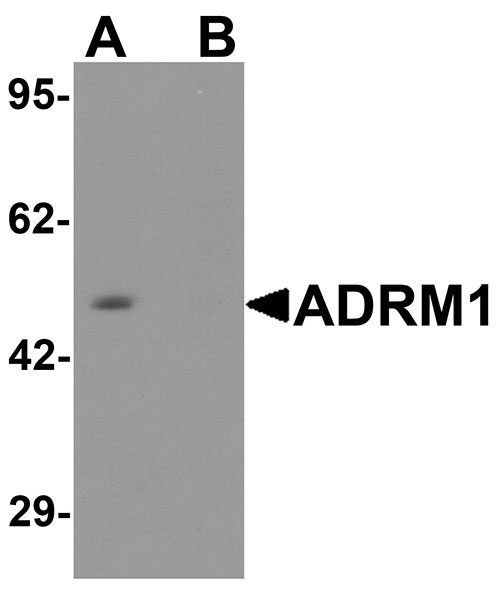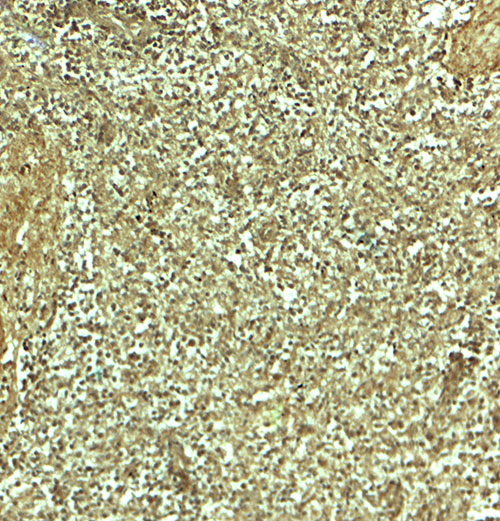ADRM1 Antibody
- 产品详情
- 实验流程
- 背景知识
Application
| WB, E, IHC-P |
|---|---|
| Primary Accession | Q16186 |
| Other Accession | NP_783163, 28373194 |
| Reactivity | Human, Mouse, Rat |
| Host | Rabbit |
| Clonality | Polyclonal |
| Isotype | IgG |
| Calculated MW | 42153 Da |
| Concentration (mg/ml) | 1 mg/mL |
| Conjugate | Unconjugated |
| Application Notes | ADRM1 antibody can be used for detection of ADRM1 by Western blot at 1 - 2 µg/mL. Antibody can also be used for immunohistochemistry starting at 5 µg/mL. |
| Gene ID | 11047 |
|---|---|
| Other Names | Proteasomal ubiquitin receptor ADRM1, 110 kDa cell membrane glycoprotein, Gp110, Adhesion-regulating molecule 1, ARM-1, Proteasome regulatory particle non-ATPase 13, hRpn13, Rpn13 homolog, ADRM1, GP110 |
| Target/Specificity | ADRM1; ADRM1 antibody is human, mouse and rat reactive. At least two isoforms of ADRM1 are know to exist; this antibody will detect both isoforms. |
| Reconstitution & Storage | ADRM1 antibody can be stored at 4℃ for three months and -20℃, stable for up to one year. |
| Precautions | ADRM1 Antibody is for research use only and not for use in diagnostic or therapeutic procedures. |
| Name | ADRM1 |
|---|---|
| Synonyms | GP110 |
| Function | Component of the 26S proteasome, a multiprotein complex involved in the ATP-dependent degradation of ubiquitinated proteins (PubMed:16815440, PubMed:16906146, PubMed:16990800, PubMed:17139257, PubMed:18497817, PubMed:24752541, PubMed:25702870, PubMed:25702872). This complex plays a key role in the maintenance of protein homeostasis by removing misfolded or damaged proteins, which could impair cellular functions, and by removing proteins whose functions are no longer required (PubMed:16815440, PubMed:16906146, PubMed:16990800, PubMed:17139257, PubMed:18497817, PubMed:24752541, PubMed:25702870, PubMed:25702872). Therefore, the proteasome participates in numerous cellular processes, including cell cycle progression, apoptosis, or DNA damage repair (PubMed:16815440, PubMed:16906146, PubMed:16990800, PubMed:17139257, PubMed:18497817, PubMed:24752541, PubMed:25702870, PubMed:25702872). Within the complex, functions as a proteasomal ubiquitin receptor (PubMed:18497817). Engages and activates 19S- associated deubiquitinases UCHL5 and PSMD14 during protein degradation (PubMed:16906146, PubMed:16990800, PubMed:17139257, PubMed:24752541). UCHL5 reversibly associate with the 19S regulatory particle whereas PSMD14 is an intrinsic subunit of the proteasome lid subcomplex (PubMed:16906146, PubMed:16990800, PubMed:17139257, PubMed:24752541). |
| Cellular Location | Cytoplasm. Nucleus |
For Research Use Only. Not For Use In Diagnostic Procedures.
Provided below are standard protocols that you may find useful for product applications.
BACKGROUND
The adhesion-regulating molecule 1 (ADRM1) is thought to be involved in protein recruitment and cell adhesion and functions as a proteasomal ubiquitin receptor (1). ADRM1 promotes the activity of UCH-L5 and plays a role in lymphocyte homing. The carboxy-terminal domain of mammalian ADRM1 serves to bind and enhance the isopeptidase activity of UCHL5/UCH37, perhaps serving as a mechanism to accelerate ubiquitin chain disassembly (2,3). ADRM1 expression is induced by IFN-gamma in some cancer cell lines and its expression is upregulated in other metastatic cells, suggesting a role in carcinogenesis (4,5).
REFERENCES
Husnjak K, Elsasser S, Zhang N, et al. Proteasome subunit Rpn13 is a novel ubiquitin receptor. Nature 2008; 453:481-8.
Yao T, Song L, Xu W, et al. Proteasome recruitment and activation of the Uch37 deubiquitinating enzyme by Adrm1. Nat. Cell Biol. 2006; 8:994-1002.
Qiu XB, Ouyang SY, Li CJ, et al. hRpn13/ADRM1/GP110 is a novel proteasome subunit that binds the deubiquitinating enzyme, UCH37. EMBO J. 2006; 25:5742-53.
Al-Shami A, Jhaver KG, Vogel P, et al. Regulators of the proteasome pathway, Uch37 and Rpn13, play distinct roles in mouse development. PLoS One 2010; 5:e13654.
终于等到您。ABCEPTA(百远生物)抗体产品。
点击下方“我要评价 ”按钮提交您的反馈信息,您的反馈和评价是我们最宝贵的财富之一,
我们将在1-3个工作日内处理您的反馈信息。
如有疑问,联系:0512-88856768 tech-china@abcepta.com.























 癌症的基本特征包括细胞增殖、血管生成、迁移、凋亡逃避机制和细胞永生等。找到癌症发生过程中这些通路的关键标记物和对应的抗体用于检测至关重要。
癌症的基本特征包括细胞增殖、血管生成、迁移、凋亡逃避机制和细胞永生等。找到癌症发生过程中这些通路的关键标记物和对应的抗体用于检测至关重要。 为您推荐一个泛素化位点预测神器——泛素化分析工具,可以为您的蛋白的泛素化位点作出预测和评分。
为您推荐一个泛素化位点预测神器——泛素化分析工具,可以为您的蛋白的泛素化位点作出预测和评分。 细胞自噬受体图形绘图工具为你的蛋白的细胞受体结合位点作出预测和评分,识别结合到自噬通路中的蛋白是非常重要的,便于让我们理解自噬在正常生理、病理过程中的作用,如发育、细胞分化、神经退化性疾病、压力条件下、感染和癌症。
细胞自噬受体图形绘图工具为你的蛋白的细胞受体结合位点作出预测和评分,识别结合到自噬通路中的蛋白是非常重要的,便于让我们理解自噬在正常生理、病理过程中的作用,如发育、细胞分化、神经退化性疾病、压力条件下、感染和癌症。







